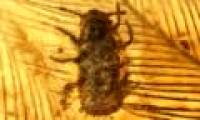
Scientists have unearthed an amber containing feathers of dinosaurs along with many ancient lice nearly 99 million years ago.

The 99 million-year-old beetle fossils excavated in Myanmar are the earliest evidence of insect pollination.

Treasure hunters believe that they have successfully deciphered the mystery of the legendary amber room that the Nazis had stolen during World War 2.

Recently, a company in Russia has discovered consecutive blocks of amber formed from ancient times with beautiful colors.

The 50 million-year-old Eocene fungus was discovered in the amber mass, next to the molting shell of an insect and a rodent's hair.

A great discovery of scientists and archaeologists in the study of the history of the structure and development of birds.

An ancient gecko preserved almost intact in the amber block dating to nearly 100 million years has been discovered by scientists in Myanmar.

German scientists found the body of an ancient spider covered with sap and died while mating with females.

Scientists at the University of Manchester, England have found fossils of a 50 million-year-old parasite that lives on a spider's body. It is considered the smallest fossil in the

With the most advanced imaging technology, European scientists have obtained unexpected holograms of fossil spider samples 49 million years ago trapped in amber.
 Scientists have unearthed an amber containing feathers of dinosaurs along with many ancient lice nearly 99 million years ago.
Scientists have unearthed an amber containing feathers of dinosaurs along with many ancient lice nearly 99 million years ago. The 99 million-year-old beetle fossils excavated in Myanmar are the earliest evidence of insect pollination.
The 99 million-year-old beetle fossils excavated in Myanmar are the earliest evidence of insect pollination. Treasure hunters believe that they have successfully deciphered the mystery of the legendary amber room that the Nazis had stolen during World War 2.
Treasure hunters believe that they have successfully deciphered the mystery of the legendary amber room that the Nazis had stolen during World War 2. Recently, a company in Russia has discovered consecutive blocks of amber formed from ancient times with beautiful colors.
Recently, a company in Russia has discovered consecutive blocks of amber formed from ancient times with beautiful colors. The 50 million-year-old Eocene fungus was discovered in the amber mass, next to the molting shell of an insect and a rodent's hair.
The 50 million-year-old Eocene fungus was discovered in the amber mass, next to the molting shell of an insect and a rodent's hair. A great discovery of scientists and archaeologists in the study of the history of the structure and development of birds.
A great discovery of scientists and archaeologists in the study of the history of the structure and development of birds. An ancient gecko preserved almost intact in the amber block dating to nearly 100 million years has been discovered by scientists in Myanmar.
An ancient gecko preserved almost intact in the amber block dating to nearly 100 million years has been discovered by scientists in Myanmar. German scientists found the body of an ancient spider covered with sap and died while mating with females.
German scientists found the body of an ancient spider covered with sap and died while mating with females. Scientists at the University of Manchester, England have found fossils of a 50 million-year-old parasite that lives on a spider's body. It is considered the smallest fossil in the
Scientists at the University of Manchester, England have found fossils of a 50 million-year-old parasite that lives on a spider's body. It is considered the smallest fossil in the With the most advanced imaging technology, European scientists have obtained unexpected holograms of fossil spider samples 49 million years ago trapped in amber.
With the most advanced imaging technology, European scientists have obtained unexpected holograms of fossil spider samples 49 million years ago trapped in amber.









 The Mystery of Biology: Why Can't We Build Airplanes With Wings Like Dragonflies?
The Mystery of Biology: Why Can't We Build Airplanes With Wings Like Dragonflies? Top 10 geniuses with the greatest inventions in history
Top 10 geniuses with the greatest inventions in history The phenomenon of 'moving borders' changes the shape of countries
The phenomenon of 'moving borders' changes the shape of countries Decoding the naming of streets in Hanoi: Surprising truths not everyone knows!
Decoding the naming of streets in Hanoi: Surprising truths not everyone knows! The Mystery and Engineering Feat of Albano Emissary: The 2,000-Year-Old Roman Tunnel
The Mystery and Engineering Feat of Albano Emissary: The 2,000-Year-Old Roman Tunnel Great ways to relieve stress and beat boredom
Great ways to relieve stress and beat boredom The snow-white mountain stands tall in the middle of the green plain: Unexpectedly, it is a giant garbage dump!
The snow-white mountain stands tall in the middle of the green plain: Unexpectedly, it is a giant garbage dump! Giant pyramid 'appears' in the middle of the highway in Mexico
Giant pyramid 'appears' in the middle of the highway in Mexico